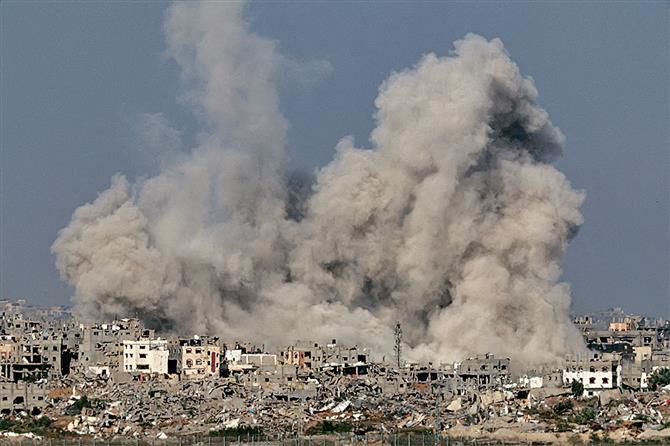The Israeli government has vowed to carry on military operations till the stated war goals are achieved.


THE Gaza war, triggered by the October 7 Hamas attack on Israel, has completed 100 days. The Israeli retaliation has killed over 24,000 Palestinians in Gaza, wounded and maimed more than 60,000 and displaced almost 90 per cent of its 2.3 million population. Gaza lies in ruins, with not a single hospital left intact and its civilian infrastructure in tatters. Scenes of horrific destruction and suffering continue to sear the world’s conscience daily as all established norms of war-fighting are being flouted with impunity by Israel.
The meticulously planned and executed Hamas attack exposed deep chinks in Israel’s security setup. Tel Aviv’s defensive strategy hinged on the twin pillars of assured early warning by the intelligence agencies and proactive deterrence action by the Israel Defence Forces (IDF). On October 7, the much-vaunted intelligence system failed and the Israeli military response to Hamas intrusions was tardy. The breaching of the ‘iron wall’ by Hamas and raiding of multiple military targets and settlements blew away the myth of Israel defences’ invincibility. Moreover, the death of hundreds of Israeli citizens in the ham-handed response has now publicly been acknowledged and is the subject of an ongoing IDF inquiry.
The Israeli concept of deterrence in the occupied territories and the neighbouring region seeks to dissuade adversaries from taking aggressive action by showcasing the proactive military might of the Israeli state, which is periodically employed to ‘mow the grass and keep the Palestinians in line’. This mode of deterrence, based on denial and punishment, has been the cornerstone of the defensive military strategy on which the current edifice of military occupation rests. The riposte for the Hamas militant attacks was swift in coming. Operation Iron Swords was launched by Israel with a threefold aim — the elimination of Hamas from Gaza, dismantling of all terrorist infrastructure and the release of all abducted hostages.ADVERTISEMENT
Fighting in built-up urban areas is every army’s worst nightmare. The challenges in Gaza are especially acute due to a large population of ‘incarcerated’ people living in a jampacked enclave of 365 sq km with a population density of a staggering 5,500 people per sq km. This led to a mushrooming vertical development of housing and other public buildings. Every narrow alley, road and open space thus becomes a killing zone in army parlance for an ingressing force. The operating forces became an easy target for the Hamas snipers and ambush teams which were located strategically to exploit the intimate knowledge of the local geography.
Keeping in mind this challenging operating environment, the IDF opted to choose the aerial bombardment route to flatten out entire neighbourhoods in the first phase of the campaign. This approach, labelled as the ‘scorched earth policy’, was a deliberate military choice to limit Israeli military casualties. The aim was to clear the demarcated axes and avenues for the movement of ground troops without any effective interference from Hamas. Consequently, areas along major roads were flattened by bombing up to hundreds of metres on each side. This has resulted in the razing of neighbourhoods, especially in northern and central Gaza. This tactic also led to very high civilian casualty rates and the allegations of the use of indiscriminate and disproportional force by the IDF.
Well-thought-out strategy and tactics do not always guarantee positive results, especially in asymmetric warfare, as the enemy quickly adapts to them. Hamas has showed remarkable flexibility and finesse in small team operations by targeting Merkava tanks, Namer APCs, D6 Bulldozers and other troop-carrying vehicles effectively with basic hand-held automatic weapons and locally manufactured rocket-propelled grenades which has resulted in the loss of lives of almost 190 IDF soldiers. Both sides have attempted to control the narrative and public opinion by proactive propaganda and outreach.
The situation in West Bank also continues to be worrisome due to the enhanced aggressive actions by the settler communities and almost daily raids into major urban centres by the security forces. More than 300 Palestinians have been killed and 4,600 detained in these areas. Aggressive Hezbollah actions have caused the displacement of about 70,000 Israeli citizens from Galilee. The role and actions of other militant groups, including the Houthis in the Red Sea, has widened the arc of confrontation. The IDF has carried out almost daily airstrikes and artillery shelling in southern Lebanon and Syria.
The Israeli government, which enjoys the unconditional backing of the US, has vowed to carry on military operations till the stated war goals are achieved. Victory in the ongoing campaign cannot be measured by military metrics. Till date, no major Hamas commander has been neutralised in Gaza. The Israeli government is loath to commit to a two-state policy espoused by the US. On the contrary, it has peddled the dream of a Greater Israel stretching from the ‘river to the sea’.
One of the outcomes which the Israel right-wing elements had hoped for and which has not happened is the displacement of a large number of homeless residents of Gaza into neighbouring countries. The beleaguered Palestinians, along with Egypt and Jordan, have ruled out another Nakba, and so has the US. Attempts are being made to trigger a US-Iran military confrontation, which both nations have avoided wisely. Gaza in the past has been described as a problem without a solution. The search for an amicable and acceptable solution continues at an expensive cost of precious lives being lost daily.
